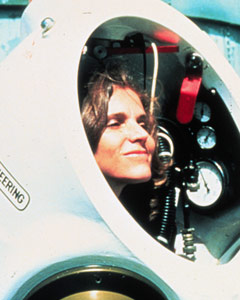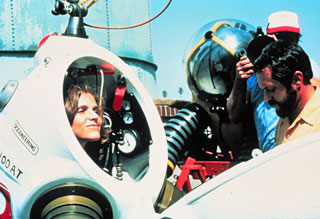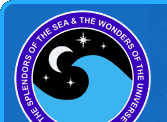
Sylvia Earle
1935 - Present
American oceanographer, explorer, aquanaut, and author, former chief scientist of NOAA.
Set a record for the deepest dive without a tether during her famous underwater walk in the JIM suit.
National Geographic Society Explorer-in-Residence, affectionately referred to as "Her Deepness" and "The Sturgeon General".
Sylvia A. Earle is an American oceanographer, explorer, aquanaut, and author. She was born on August 30, 1935 in Gibbstown, New Jersey. She was raised on a small farm near Camden. She loved exploring the woods near her home and was fascinated by the animals and plants she found there. Her parents taught her to respect wild animals and to not be afraid of the unknown. During family trips to the Jersey shore, she discovered a magical world of wildlife at the water's edge. When she was 13 years old, her family moved to Clearwater, Florida. Sylvia became interested in the wildlife of the Florida Gulf coast. She described the experience as "living on the edge of the great unknown every day." She attempted her first dive at age 16 using a diving helmet, since scuba was not yet available. She excelled in school and earned a scholarship to Florida State University. As she attended college, she supported herself by working in college laboratories. While working at the college, she learned how to scuba dive and was eager to study marine life. She decided to study botany and believed that understanding plants is the first step to understanding any ecosystem. She earned her Master's degree at Duke University. Her dissertation Phaeophyta of the Eastern Gulf of Mexico earned her a reputation in the scientific community. She has since made it a lifelong project to catalog every species of plant in the Gulf of Mexico.

After graduating from Duke, Sylvia took some time off to marry and start a family. In 1964 she left home for six weeks to join an expedition in the Indian Ocean funded by the National Science Foundation. During the remainder of the sixties, she joined a number of scientific expeditions that took her all over the world. Her career took her to Harvard as a research fellow and then to the Cape Haze Marine Laboratory as resident director. In 1968, while four months pregnant, she became the first woman scientist to look out through the porthole of a submarine as she dived 100 feet (30 meters) in the submersible Deep Diver. In 1969 she applied for the Tektite project, sponsored by the U.S. Navy, the Department of the Interior, and NASA. The Tektite project allowed teams of scientists to spend weeks at a time in an underwater habitat on the ocean floor off the coast of the Virgin Islands. Unfortunately she was rejected in spite of the fact that she had over 1,000 research hours underwater. It seems the project did not want men and women living underwater together. But Sylvia was persistent and in 1970 the Tektite 2 project was launched with an all female crew led by Dr. Earle herself. Sylvia and four other women spent two weeks 50 feet (15 meters) underwater in the habitat studying ocean life and examining the effects of living underwater on the human body. After the women returned to the surface, they were surprised to find that they had become celebrities. They were even given a ticker tape parade and White House reception. Afterwards, Sylvia was in demand as a public speaker. She began to write for National Geographic and to produce books and films. She had discovered the secret to reaching the public through media, just as Jacques Cousteau had.

dive in the JIM suit
In the 1970s, Sylvia traveled the world with scientific expeditions to Panama, China, The Indian Ocean, the Galapagos, and the Bahamas. She met underwater photographer Al Giddings and they began to collaborate on a number of projects. In 1977 they made their first voyage to follow the sperm whales. The expedition was recorded in the documentary film Gentle Giants of the Pacific. In 1979 Sylvia made her famous untethered walk on the sea floor with the JIM suit. Using a pressurized metal suit resembling a space suit, she walked for two and a half hours at a depth of 1,250 feet (381 meters). Only a communication line connected here to a submersible. She recorded the adventure in her book, Exploring the Deep Frontier. In 1982 Sylvia and her husband founded the companies Deep Ocean Engineering and Deep Ocean Technologies to design and build deep-sea submersibles. In the early 1990s Sylvia took a leave of absence from her companies to serve as Chief Scientist of the National Oceanographic and Atmospheric Administration (NOAA). She is currently an Explorer in Residence at the National Geographic Society. To date she has led over 70 expeditions, logging more than 6,500 hours underwater. She has received more than 100 national and international honors and has written more than 180 publications about marine science and technology. She recently led expeditions to Cuba in 2009 and Belize and the Galapagos Islands in 2010. She continues to be an advocate for ocean conservation and has written proposals to establish a network of marine protected areas she calls "hope spots".




